PackandGo.info is an invitation to explore the world and different cultures. There are different ways to reach those objectives. Food and drinks are some of our favorite.
We already have shared with you our love for Mexican mezcal. And happily, some of you agree with us about how delicious the spirit mezcal is. Others are curious and asked more details about it. That’s why we are back here to provide more interesting facts about mezcal.
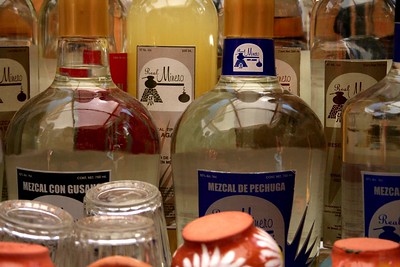
What does mezcal mean?
The word mezcal means cooked agave. It comes from the Nahuatl language. Mezcal word is used in Mexico to refer to all spirits distilled from agave plants (there’s a wide variety of them), without considering at this point, if they have the legal certification to be called mezcal or not. It’s an umbrella term to group beverages like raicilla, bacanora, sotol, and tequila. And mezcal is also used to point directly to a specific and certified Mexican spirit of artisan origin.
Pulque, another popular Mexican beverage, is not a mezcal because it’s produced with agave but it’s fermented, not distilled like the others we mentioned.
Learn more about mezcal's taste and how it is produced here!
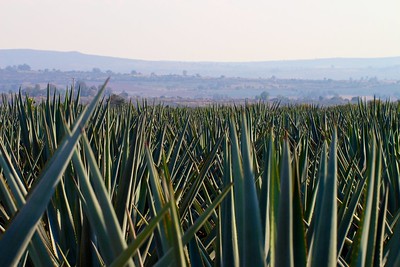
What’s agave?
The agave is an endemic Mexican plant. Since pre-Hispanic times, the agave and its different varieties have been used due to their medicinal properties, to build structures such as roofs and walls, channels to conduct water, to produce paper, fabrics, ornaments, and of course, alcoholic beverages such as aguamiel and pulque. Already from that time, the plant was fully exploited. Its spines or spikes are used in rituals and as sewing needles. Its flowers were food, part of different dishes of the time.
Agave’s native environments are the arid, hot, and even tropical regions along the American continent. They are plants with large rosettes made up of fleshy and strong leaves.
| Follow PackAndGo.info at: | |
| YouTube | @packandgo. |
| @packandgo.info | |
| X | @packandgoinfo |
| Bluesky | @packandgo.bsky.social |
| @packandgo.info | |
| TikTok | @packandgo.info |
Mexico has approximately 200 species of agave. Only between 12 and 15 are used to produce mezcal. Each mezcal is associated with a species of agave and a specific region.
Commonly, the agave to distill mezcal is a plant with long and fibrous lanceolate leaves, bluish-green. The pineapple or head, which includes the stem and the base of its leaves, is what is used to make mezcal. The maturation process of the plant takes between seven and ten years. Crop cycles are different in each region.
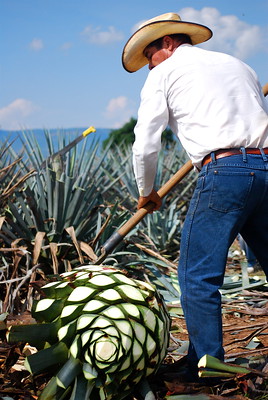
What’s the difference between agave and maguey?
There’s no real difference between agave (agaves, plural) and maguey (magueyes, plural). They are ways to call the same variety of plants. Agave is the scientific name defined by the naturalist Carlos Linneo, in 1753 for these plants.
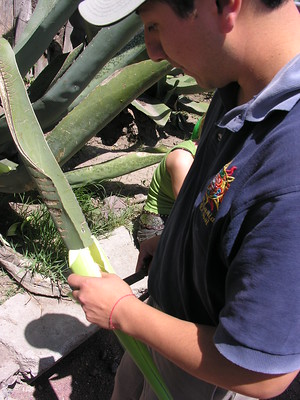
When the Spanish conquerors arrived in the American continent they found agaves and for them, at least at first glance, they were similar to the aloe plants the natives of the Antilles named maguey. So they used the same name. Before the Aztecs called it metl, the Zapotecs named it toba, and Mayas, ki.
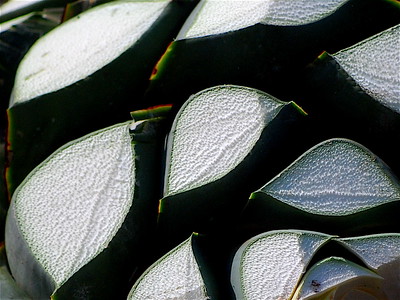
Why do Mexicans drink mezcal with orange?
There are different recommendations people give to have a better experience while drinking mezcal. A popular one is to drink it accompanied by orange slices, seasoned with salt mixed with pulverized agave worms, and ground chili peppers. Worms can sound strange or disgusting but they are tasty and safe for your health. These worms naturally live in the agave and the only thing they eat, day after day, is agave and its juice. They are mezcal worms!
The objective of drinking mezcal with orange is to make it lighter for the palate. This makes the experience more pleasant because it enlarges the experience through a gourmet touch. Besides, it's good for beginners or people not very used to drinking alcoholic beverages.
If you are into mixology, here we have some great mezcal cocktails for you!

What is worm salt for mezcal?
It’s salt mixed with worm and chili. It was created in the Mexican state of Oaxaca and it was part of the Aztec emperors' menu. It’s prepared following the pre-Hispanic recipe and through artisanal processes.
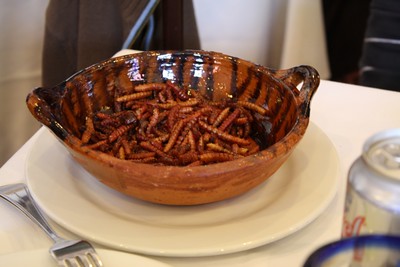
Adult agave worms are collected, mainly between July and December. The worms are dried and ground to mix with chili and salt. The mixture is dry in the sun and is pulverized. In this way, a powder with brown and red tones is obtained, with an intense and pleasant flavor. It is widely used to accompany mezcal and fresh fruit, but also as a spice in Mexican cuisine, gourmet cuisine included.
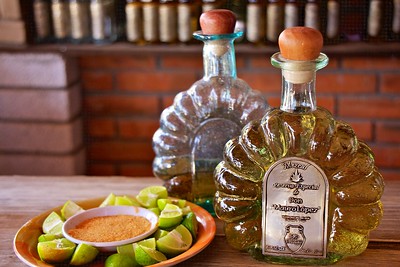
Can you take shots of mezcal?
It is up to you. Yes, you can take shots of mezcal but it’s not a recommended way to enjoy this spirit. You will get drunk faster but you will miss a lot of the tasty experience if you just pour it directly to your throat. Mezcal is a spirit to be enjoyed sip by sip. This is the way to feel the taste and aroma of its ingredients, its consistency, texture, and its whole body.
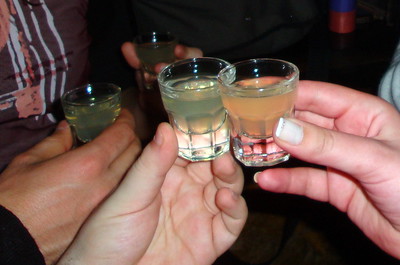
What’s the difference between mezcal and tequila?
Shortly answering, the difference between mezcal and tequila (What is tequila?) is the taste. Both spirits have different flavors. And this is the result of several factors. Agave varieties used to produce mezcal are different from the ones used to produce tequila. They belong to different Mexican regions. The production process of these beverages and the tools or machinery (like ovens) involved are also different.
Does mezcal taste like tequila?
Not at all. Mezcal does not taste like tequila (FAQ about tequila). Both are iconic Mexican beverages produced from agave. But the types of agave to produce each beverage are different, just like their corresponding production processes and recipes.
Does mezcal have to be made in Mexico?
Mezcal is a Mexican beverage and legally it has to comply with the Mexican Official Standard (NOM) to be certified as mezcal so it can be distributed under such denomination.
In a wider view, there are around 200 different varieties of agave growing into arid and semiarid zones in the American continent, specifically Mexico, the South of the US, and the Caribbean. If a proper variety to produce mezcal grows somewhere out of Mexico and someone has the expertise and tools to produce, technically it could be made elsewhere. For selling and exporting the product for sure you should check legal aspects more in detail.

Is mezcal cheaper in Mexico?
Possibly yes, mezcal can be cheaper in Mexico. The reason is if you buy the Mexican spirit in another country for sure there will be importation taxes involved. Just to give an example, in some American shops, Mexican mezcal bottles from regular brands can start at 200 USD. While top brands and types in Mexico can cost from 150 USD to 200 USD.
Is mezcal dangerous?
Mezcal is not dangerous if it’s properly produced and if it’s certified. As we already explained, mezcal has been distilled in Mexico since 400 BC. It has been a long time a homemade spirit. In the past, the lack of regulation and existence of an official standard originated some accidents. When mezcal is not produced correctly, methanol can be part of it, and it’s a toxic alcohol that based on the amount that is consumed can get people blind and dead.
Ethanol is alcohol too but it’s the one that should be present in fermented beverages in concentrations from 5% to 20% in wines and beer, up to 40% in vodka, whisky, tequila, etc. The human body can only process from 10 to 15 milliliters of ethanol every hour. More than this can be lethal.
So methanol and ethanol are types of alcohol but they are not the same.
That’s why entities in charge of people to respect the official standards to avoid risks were created. Buy a certified mezcal and you will be safe.

Where in Mexico is mezcal produced?
Nowadays, there’s an Official Mexican Standard and appellation of origin to regulate and protect its production in the Mexican states of Oaxaca, Estado de México, Morelos, Aguascalientes, Zacatecas, Tamaulipas, Puebla, San Luis Potosí, Michoacán, Guerrero, Guanajuato and Durango.
How to identify certified mezcal?
To identify certified mezcal looked for this information in the bottle’s tag. There, the appellation of origin must be shown to point to the Mexican state in which mezcal was produced. Besides, the bottle must have the hologram issued by the Mezcal Regulatory Council (CRM), which endorses the certification of the mezcal. Like this, you can confirm that the mezcal bottle you want to buy complies with the quality and production standards.
Can I bring mezcal from Mexico?
Yes, you can bring mezcal to your country from Mexico. You can buy mezcal online. And you can take it with you from Mexico on the airplane. You just need to check the policies of your airline. Usually, they seem to allow 5 liters of alcoholic beverages in the checked baggage. If you exceed this limit, you should declare them and pay extra taxes. But this can change from country to country and in the different airlines.
Do you refrigerate mezcal?
As a result of its origin and production process, mezcal has many natural congeners. They are essential components of mezcal’s flavor and chilling dulls them. Better avoid the fridge, freezer and skip the ice unless you are preparing a cocktail.
How to preserve mezcal?
Preserve mezcal by storing it in dry and cool areas, protected from direct sunlight or heat. Once it’s opened, keep it tightly closed when you don’t consume it. These practices can make longer the life and quality of your mezcal.
Experts say when the mezcal bottle is opened, the spirit starts a slow evaporation process that, after time and based on the storing conditions, can affect its flavor. They say an opened mezcal bottle properly stored can keep its quality around 9 months.

Conclusion
If you like spirits, you should give mezcal a try. It’s not only alcohol but a complete and pleasant experience for the palate. The ingredients used to produce the mezcal, the way to prepare it, the kind of agave, time, everything gets reflected in the taste of the spirit. Mezcal is a delicious sip of Mexico!
Share your experience with us:
| Follow PackAndGo.info at: | |
| YouTube | @packandgo. |
| @packandgo.info | |
| X | @packandgoinfo |
| Bluesky | @packandgo.bsky.social |
| @packandgo.info | |
| TikTok | @packandgo.info |
